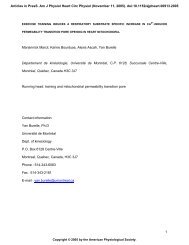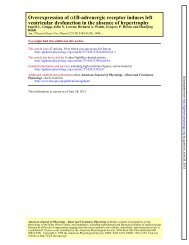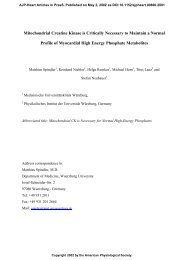The role of eNOS, iNOS and NFκB in upregulation and activation of ...
The role of eNOS, iNOS and NFκB in upregulation and activation of ...
The role of eNOS, iNOS and NFκB in upregulation and activation of ...
Create successful ePaper yourself
Turn your PDF publications into a flip-book with our unique Google optimized e-Paper software.
Ye Y, et al. Mechanisms <strong>of</strong> COX2 <strong>upregulation</strong> by atorvastat<strong>in</strong> 16<br />
<strong>eNOS</strong>, as has been described for the delayed form <strong>of</strong> ischemic precondition<strong>in</strong>g [10] [23].<br />
It has been suggested that <strong>eNOS</strong> <strong>activation</strong> leads to <strong>activation</strong> <strong>of</strong> soluble guanylate<br />
cyclase, prote<strong>in</strong> k<strong>in</strong>ase C (PKC ), NF B, <strong>and</strong> Janus k<strong>in</strong>ase (JAK)-signal transducers <strong>and</strong><br />
activators <strong>of</strong> transcription (STAT) pathways, lead<strong>in</strong>g to <strong>activation</strong> <strong>of</strong> <strong>iNOS</strong> <strong>and</strong>/or COX2<br />
[3; 9-11] [23]. In contrast, <strong>in</strong> other models <strong>eNOS</strong> has been reported to <strong>in</strong>hibit NF B<br />
<strong>activation</strong> [45]. This may reflect that NF B <strong>activation</strong> <strong>in</strong>volves both <strong>in</strong>flammatory<br />
signal<strong>in</strong>g (p65/p50) <strong>and</strong> anti-<strong>in</strong>flammatory signal<strong>in</strong>g (cRel/p52) as well as other non-<br />
canonical pathways. It is probable that the <strong>upregulation</strong> <strong>of</strong> <strong>iNOS</strong> by ATV is NF B-<br />
dependent (Figure 6). Indeed, both NF B <strong>and</strong> <strong>iNOS</strong> expression <strong>and</strong> activity were not<br />
<strong>in</strong>creased by ATV <strong>in</strong> the <strong>eNOS</strong> -/- mice.<br />
Our data suggest that the expression <strong>of</strong> COX2 is dependent on the presence <strong>of</strong> <strong>in</strong>tact<br />
<strong>iNOS</strong>, as COX2 expression was not <strong>in</strong>creased <strong>in</strong> the <strong>iNOS</strong> -/- mice despite <strong>activation</strong> <strong>of</strong><br />
NF B. Previously it has been shown that 24 hours after ischemic precondition<strong>in</strong>g<br />
stimulus, COX2 expression was <strong>in</strong>creased <strong>in</strong> both WT <strong>and</strong> <strong>iNOS</strong> -/- mice, suggest<strong>in</strong>g that<br />
with a more robust stimulus than stat<strong>in</strong> pretreatment, such as precondition<strong>in</strong>g, <strong>iNOS</strong> is not<br />
essential for COX2 <strong>upregulation</strong> [50]. Although <strong>iNOS</strong> expression <strong>and</strong> c<strong>iNOS</strong> activity<br />
were not <strong>in</strong>creased by ATV <strong>in</strong> the <strong>eNOS</strong> -/- mice, the presence <strong>of</strong> <strong>in</strong>tact <strong>iNOS</strong> gene may<br />
enable COX2 <strong>upregulation</strong>. Alternatively, a gene adjacent to <strong>iNOS</strong> on chromosome 10<br />
that is responsible for upregulat<strong>in</strong>g COX2 expression could have been erroneously<br />
deleted <strong>in</strong> the <strong>iNOS</strong> -/- mice. However, as pioglitazone, a PPAR- agonist augments COX2<br />
expression <strong>in</strong> the same <strong>iNOS</strong> -/- mice stra<strong>in</strong> [8], this is probably not the explanation.<br />
<strong>The</strong> over-expressed COX2 <strong>in</strong> the ATV-treated <strong>eNOS</strong> -/- mice was not activated <strong>and</strong> not S-<br />
nitrosylated. Although we cannot exclude the possibility that <strong>eNOS</strong> S-nitrosylates COX2<br />
Copyright Information<br />
Page 16 <strong>of</strong> 35






